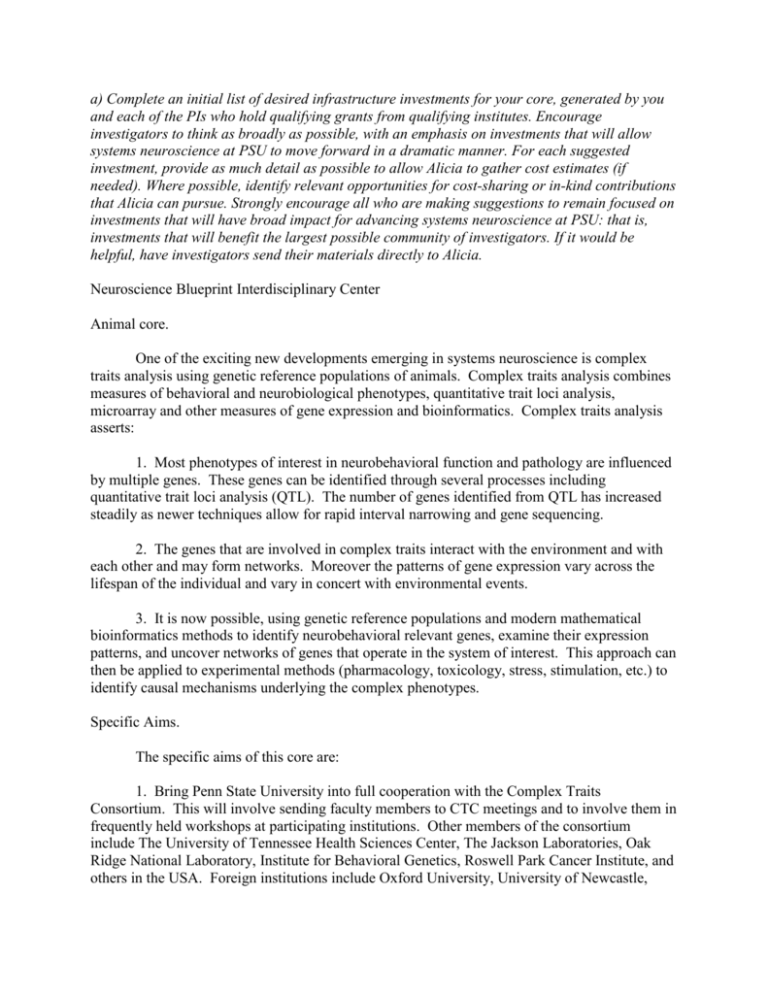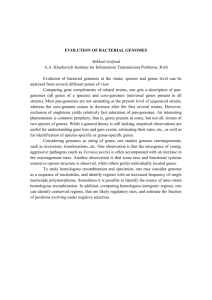a) Complete an initial list of desired infrastructure investments for
advertisement

a) Complete an initial list of desired infrastructure investments for your core, generated by you and each of the PIs who hold qualifying grants from qualifying institutes. Encourage investigators to think as broadly as possible, with an emphasis on investments that will allow systems neuroscience at PSU to move forward in a dramatic manner. For each suggested investment, provide as much detail as possible to allow Alicia to gather cost estimates (if needed). Where possible, identify relevant opportunities for cost-sharing or in-kind contributions that Alicia can pursue. Strongly encourage all who are making suggestions to remain focused on investments that will have broad impact for advancing systems neuroscience at PSU: that is, investments that will benefit the largest possible community of investigators. If it would be helpful, have investigators send their materials directly to Alicia. Neuroscience Blueprint Interdisciplinary Center Animal core. One of the exciting new developments emerging in systems neuroscience is complex traits analysis using genetic reference populations of animals. Complex traits analysis combines measures of behavioral and neurobiological phenotypes, quantitative trait loci analysis, microarray and other measures of gene expression and bioinformatics. Complex traits analysis asserts: 1. Most phenotypes of interest in neurobehavioral function and pathology are influenced by multiple genes. These genes can be identified through several processes including quantitative trait loci analysis (QTL). The number of genes identified from QTL has increased steadily as newer techniques allow for rapid interval narrowing and gene sequencing. 2. The genes that are involved in complex traits interact with the environment and with each other and may form networks. Moreover the patterns of gene expression vary across the lifespan of the individual and vary in concert with environmental events. 3. It is now possible, using genetic reference populations and modern mathematical bioinformatics methods to identify neurobehavioral relevant genes, examine their expression patterns, and uncover networks of genes that operate in the system of interest. This approach can then be applied to experimental methods (pharmacology, toxicology, stress, stimulation, etc.) to identify causal mechanisms underlying the complex phenotypes. Specific Aims. The specific aims of this core are: 1. Bring Penn State University into full cooperation with the Complex Traits Consortium. This will involve sending faculty members to CTC meetings and to involve them in frequently held workshops at participating institutions. Other members of the consortium include The University of Tennessee Health Sciences Center, The Jackson Laboratories, Oak Ridge National Laboratory, Institute for Behavioral Genetics, Roswell Park Cancer Institute, and others in the USA. Foreign institutions include Oxford University, University of Newcastle, University of Bordeaux, Tel Aviv University, University of Edinburgh, Uppsala University and others. 1.1 Workshop participation for faculty 2@ $2500 each per year 2. Hire three faculty over 3 years as Life Sciences Institute co-Hires. At least one of the hires would be in the area of neuroinformatics and the rest would be in systems neurogenetics. We envision that this investment would be part of the cost sharing required of Penn State. 3. Develop one genetic reference population of mice initially. This would consist of bringing the 80 extant BXD recombinant inbred strains in a breeding colony and made available to neuroscience investigators at UP and HMC campuses. Costs involved would include 3.1. 80X6 animals at $50.00 each to establish a breeding colony. Direct cost. 3.2. Animal per diem – 500 animals maintained at .20 per day X 365 days = 36,500 per year for the breeding colony. Direct cost. Researchers using the mice would receive weanlings free of charge, but would be responsible for per diem costs thereafter. 3.3 Barrier facility dedicated to the RI strains as shared costs 3.4 15% teaching release for core PI for overall supervision as shared costs 3.5 One full-time technician to assist with breeding, maintenance of records, etc. Direct cost. 4. In 2 or 3 years, participate in the collaborative cross project. This project involves the development of 1000 recombinant inbred strains through the collaboration of several institutions in the USA and in the UK. All of the strains would be densely genotyped for known markers and SNPs and the investigator would be able to order mice based on allelic configurations of interest.






